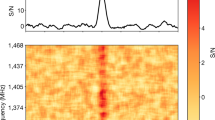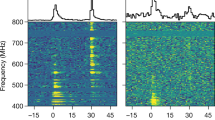Abstract
Fast radio bursts (FRBs) are millisecond radio pulses originating from powerful enigmatic sources at extragalactic distances. Neutron stars with large magnetic fields (magnetars) have been considered as the sources powering the FRBs, but the connection requires further substantiation. Here we report the detection by the AGILE satellite on 28 April 2020 of an X-ray burst in temporal coincidence with a bright FRB-like radio burst from the Galactic magnetar SGR 1935+2154. The burst observed in the hard X-ray band (18–60 keV) lasted about 0.5 s, it is spectrally cut off above 80 keV and implies an isotropically emitted energy of about 1040 erg. This event demonstrates that a magnetar can produce X-ray bursts in coincidence with FRB-like radio bursts. It also suggests that FRBs associated with magnetars can emit X-ray bursts. We discuss SGR 1935+2154 in the context of FRBs with low–intermediate radio energies in the range 1038–1040 erg. Magnetars with magnetic fields B ≈ 1015 G may power these FRBs, and new data on the search for X-ray emission from FRBs are presented. We constrain the bursting X-ray energy of the nearby FRB 180916 to be less than 1046 erg, smaller than that observed in giant flares from Galactic magnetars.
This is a preview of subscription content, access via your institution
Access options
Access Nature and 54 other Nature Portfolio journals
Get Nature+, our best-value online-access subscription
$29.99 / 30 days
cancel any time
Subscribe to this journal
Receive 12 digital issues and online access to articles
$119.00 per year
only $9.92 per issue
Buy this article
- Purchase on SpringerLink
- Instant access to full article PDF
Prices may be subject to local taxes which are calculated during checkout





Similar content being viewed by others
Data availability
The data used in this investigation are available on demand at the helpdesk of the AGILE website: https://agile.ssdc.asi.it. The data that support the plots within this paper are available from the corresponding author.
References
Lorimer, D. R., Bailes, M., McLaughlin, M. A., Narkevic, D. J. & Crawford, F. A. A bright millisecond radio burst of extragalactic origin. Science 318, 777–780 (2007).
Petroff, E., Hessels, J. W. & Lorimer, D. R. Fast radio bursts. Astron. Astrophys. Rev. 27, 4 (2019).
Cordes, J. M. & Chatterjeee, S. Fast radio bursts: an extragalactic enigma. Annu. Rev. Astron. Astrophys. 57, 417–465 (2019).
Kaspi, V. & Beloborodov, A. M. Magnetars. Annu. Rev. Astron. Astrophys. 55, 261–301 (2017).
Scholz, et al. A bright millisecond-timescale radio burst from the direction of the Galactic magnetar SGR 1935+2154. Astron. Telegr. 13681 (2020).
Bochenek, C. et al. Independent detection of the radio burst reported in ATel #13681 with STARE2. Astron. Telegr. 13684 (2020).
Stamatikos, M., Malesani, D., Page, K. L. & Sakamoto, T. GRB 140705A: swift detection of a short burst. GRB Coord. Netw. 16520 (2014).
Kothes, R., Sun, X., Gaensler, B. & Reich, W. A radio continuum and polarization study of SNR G57.2 + 0.8 associated with magnetar SGR 1935+2154. Astrophys. J. 852, 54 (2018).
Israel, G. et al. The discovery, monitoring and environment of SGR J1935+2154. Mon. Not. R. Astron. Soc. 457, 3448–3456 (2016).
Hurley, K. et al. IPN triangulation of a bright burst from SGR 1935+2154. GRB Coord. Netw. 27625 (2020).
Tavani, M. et al. The AGILE mission. Astron. Astrophys. 502, 995–1013 (2009).
Ursi, A. et al. AGILE detection of a short and hard X-ray burst possibly related to SGR 1935+2154. GRB Coord. Netw. 27687 (2020).
Tavani, M. et al. AGILE detection of a hard X-ray burst in temporal coincidence with a radio burst from SGR 1935+2154. Astron. Telegr. 13686 (2020).
Mereghetti, S. et al. INTEGRAL discovery of a burst with associated radio emission from the magnetar SGR 1935+2154. Astrophys. J. Lett. 898, L29 (2020).
Ridnaia, A. et al. A peculiar hard X-ray counterpart of a Galactic fast radio burst. Nat. Astron. https://doi.org/10.1038/s41550-020-01265-0 (2020).
Zhang, S.-N. et al. Insight-HXMT X-ray and hard X-ray detection of the double peaks of the fast radio burst from SGR 1935+2154. Astron. Telegr. 13696 (2020).
Locatelli, N. T. et al. The Northern Cross fast radio burst project—I. Overview and pilot observations at 408 MHz. Mon. Not. R. Astron. Soc. 494, 1229–1236 (2020).
Pilia, M. et al. The lowest frequency fast radio bursts: Sardinia Radio Telescope detection of the periodic FRB 180916 at 328 MHz. Astrophys. J. Lett. 896, L40 (2020).
Burgay, M. et al. Marginal detection of radio pulsations from the magnetar SGR 1935+2154 with the Medicina Northern Cross. Astron. Telegr. 13783 (2020).
Marcote, B. et al. A repeating fast radio burst source localized to a nearby galaxy. Nature 577, 190–194 (2020).
Spitler, L. G. et al. A repeating fast radio burst. Nature 531, 202–205 (2016).
CHIME/FRB Collaboration A second source of repeating fast radio bursts. Nature 566, 235–238 (2019).
CHIME/FRB Collaboration CHIME/FRB discovery of eight new repeating fast radio burst sources. Astrophys. J. 885, L24 (2019).
Scholz, P. et al. Simultaneous X-ray, gamma-ray, and radio observations of the repeating fast radio burst FRB 121102. Astrophys. J. 846, 80 (2017).
Kirsten, F. et al. Simultaneous multi-frequency limits on radio emission at the time of a bright X-ray burst from SGR 1935+2154. Astron. Telegr. 13735 (2020).
Lyutikov, M. Radio emission from magnetars. Astrophys. J. 580, L65–L68 (2002).
Kumar, P., Lu, W. & Bhattacharya, M. Fast radio burst source properties and curvature radiation model. Mon. Not. R. Astron. Soc. 468, 2726–2739 (2017).
Lyubarsky, Y. A model for extragalactic radio bursts. Mon. Not. R. Astron. Soc. 442, L9–L13 (2014).
Beloborodov, A. M. A flaring magnetar in FRB 121102? Astrophys. J. 843, L26 (2017).
Palmer, D. M. et al. A giant γ-ray flare from the magnetar SGR 1806−20. Nature 434, 1107–1109 (2005).
Hurley, K. et al. An exceptionally bright flare from SGR 1806−20 and the origins of short-duration γ-ray bursts. Nature 434, 1098–1103 (2005).
Tendulkar, S. P., Kaspi, V. M. & Patel, C. Radio non-detection of the SGR 1806−20 giant flare and implications for fast radio bursts. Astrophys. J. 827, 59 (2016).
Borghese, A. et al. X-ray monitoring of the active magnetar SGR 1935+2154. Astron. Telegr. 13720 (2020).
Airi, M. et al. Periodic activity from a fast radio burst source. Nature 582, 351–355 (2020).
Tavani, M. et al. Gamma-ray and X-ray observations of the periodic-repeater FRB 180916 during active phases. Astrophys. J. Lett. 893, L42 (2020).
Scholz, P. et al. Simultaneous X-ray and radio observations of the repeating fast radio burst FRB 180916.J0158+65. Astrophys. J. 901, 165 (2020).
Metzger, B. D., Margalit, B. & Sironi, L. Fast radio bursts as synchrotron maser emission from decelerating relativistic blast waves. Mon. Not. R. Astron. Soc. 485, 4091–4106 (2019).
Margalit, B., Beniamini, P., Sridhar, N. & Metzger, B. D. Implications of a fast radio burst from a Galactic magnetar. Astrophys. J. Lett. 899, L27 (2020).
Casentini, C. et al. AGILE observations of two repeating fast radio bursts with low intrinsic dispersion measures. Astrophys. J. Lett. 890, L32 (2020).
Katz, J. Are fast radio bursts made of neutron stars? Mon. Not. R. Astron. Soc. 494, L64–L68 (2020).
Main, R. et al. Pulsar emission amplified and resolved by plasma lensing in an eclipsing binary. Nature 557, 522–525 (2018).
Thompson, C. & Duncan, R. C. The soft gamma-ray repeaters as very strongly magnetized neutron stars—I. Radiative mechanisms for outbursts. Mon. Not. R. Astron. Soc. 275, 255–300 (1995).
Hoshino, M. & Arons, J. Preferential positron heating and acceleration by synchrotron maser instabilities in relativistic positron–electron–proton plasmas. Phys. Fluids B 3, 818–833 (1991).
Plotnikov, I. & Sironi, L. The synchrotron maser emission from relativistic shocks in fast radio bursts: 1D PIC simulations of cold pair plasmas. Mon. Not. R. Astron. Soc. 485, 3816 (2019).
Kumar, P. & Lu, W. Radiation forces constrain the FRB mechanism. Mon. Not. R. Astron. Soc. 494, 1217–1228 (2020).
Ridnaia, A. et al. Konus–Wind observation of hard X-ray counterpart of the radio burst from SGR 1935+2154. GRB Coord. Netw. 27669 (2020).
Connaughton, V. et al. Fermi GBM observations of LIGO gravitational-wave event GW 150914. Astrophys. J. Lett. 826, L6 (2016).
Hill, J. E. et al. Readout modes and automated operation of the Swift X-ray Telescope. Proc. SPIE 5165, https://doi.org/10.1117/12.505728 (2004).
Petroff, E. et al. FRBCAT: the fast radio burst catalogue. Publ. Astron. Soc. Aust. 33, e045 (2016).
Prochaska, J. X. & Zheng, Y. Probing Galactic haloes with fast radio bursts. Mon. Not. R. Astron. Soc. 485, 648–665 (2019).
McQuinn, M. Locating the “missing” baryons with extragalactic dispersion measure estimates. Astrophys. J. Lett. 780, L33 (2014).
Cordes, J. M., Joseph, T., Lazio, W., NE2001. I. A new model for the galactic distribution of free electrons and its fluctuations. Preprint at https://arxiv.org/abs/astro-ph/0207156 (2002).
Tendulkar, S. P. et al. The host galaxy and redshift of the repeating fast radio burst FRB 121102. Astrophys. J. Lett. 834, L7 (2017).
Bannister, K. W. et al. A single fast radio burst localized to a massive galaxy at cosmological distance. Science 365, 565–570 (2019).
Prochaska, J. X. et al. The low density and magnetization of a massive galaxy halo exposed by a fast radio burst. Science 366, 231–234 (2019).
Ravi, V. et al. A fast radio burst localized to a massive galaxy. Nature 572, 352–354 (2019).
Macquart, J. P. et al. A census of baryons in the Universe from localized fast radio bursts. Nature 581, 391–395 (2020).
Acknowledgements
AGILE is a space mission of the Italian Space Agency (ASI) developed and operated with the collaboration of INAF and INFN. The research was carried out with partial support by the ASI grants I/028/12/05 and ASI 2014-049-R.0. We acknowledge satellite operations at the ground station in Malindi (Kenya) and at AGILE mission operation centre in Fucino (Italy). We also acknowledge the scientific ground segment activities at the ASI Space Science Data Center. We thank the team of the Neil Gehrels Swift Observatory for assistance in supporting X-ray observations. We thank D. D. Frederiks for useful exchanges.
Author information
Authors and Affiliations
Contributions
M. Tavani wrote the manuscript together with C.C., F.V. and A.U. C.P., F. Lucarelli and F.V. oversaw the AGILE satellite data flow and pipelines at the ASI Space Science Data Center. A.B., N.P., A. Argan, V.F. and L.B. contributed to the SW management and AGILE instrument pipelines. M.P. and S.P. contributed to the analysis of X-ray data. G. Bernardi, G. Bianchi, M.P., A. Magro, G.N., G. Pupillo and G.S. contributed to the analysis of radio data at the Northern Cross. Other authors belong to the whole AGILE team that contributed to supporting the writing of the manuscript and providing technical information and cross-check.
Corresponding author
Ethics declarations
Competing interests
The authors declare no competing interests.
Additional information
Peer review information Nature Astronomy thanks the anonymous reviewers for their contribution to the peer review of this work.
Publisher’s note Springer Nature remains neutral with regard to jurisdictional claims in published maps and institutional affiliations.
Rights and permissions
About this article
Cite this article
Tavani, M., Casentini, C., Ursi, A. et al. An X-ray burst from a magnetar enlightening the mechanism of fast radio bursts. Nat Astron 5, 401–407 (2021). https://doi.org/10.1038/s41550-020-01276-x
Received:
Accepted:
Published:
Issue Date:
DOI: https://doi.org/10.1038/s41550-020-01276-x



